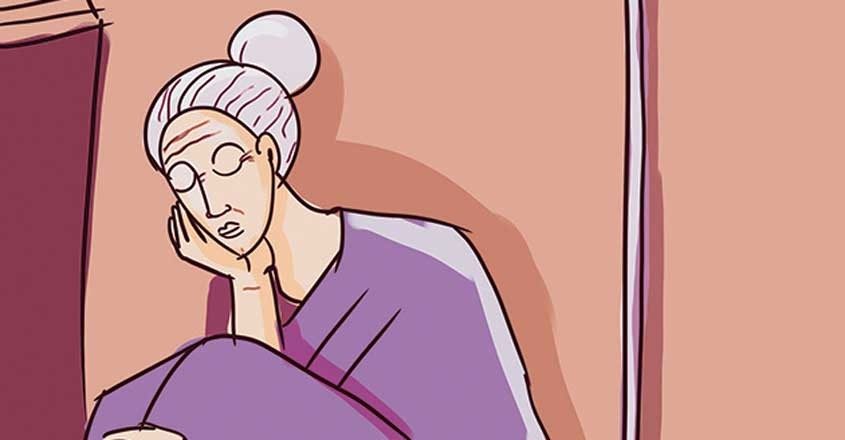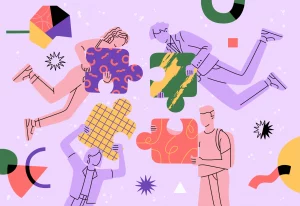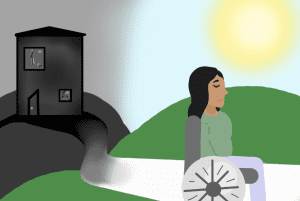Why Elderly Women With Disabilities Are At Highest Risk of Abuse, Neglect
- Shreya Raman

Forced to depend on their family for support and care because of social norms and ineffective government policies, elderly women with disabilities are highly vulnerable to neglect and abuse in India, show studies and the material we collected through extensive interviews with researchers, activists and those affected.
Why is it important for India to have more robust and supportive policies on the health and wellbeing of the elderly, especially those with disabilities? Increased longevity and falling fertility rates are prompting a fast demographic change in the country. By 2061, a quarter of India’s population will be elderly, as per a population projection by the United Nations Population Fund (UNFPA). In another 10 years, the number of the elderly will nearly double from the 2011 figure of 104 million to reach 194 million.
Upto 21% of the total number of disabled persons in India are aged 60 and above, 18% of them male and 23% female, according to Census (2011). And 12% of the elderly population reported multiple disabilities. These numbers may be higher as the categories of disability have expanded after the the Rights of Persons with Disabilities Act, 2016 was passed in 2016.
Demographic changes and the increase in chronic health conditions will lead to an increase in the number of persons with disabilities: a 2012 study estimated that there would be 3.5 million more disabled people in India every year because of just three reasons — an increase in traumatic brain injury from road traffic accidents, increase in incidence of stroke and increased risk of dementia. This is equal to the population of Dubai.Studies have shown that older women are more likely than men to become and remain disabled due to the presence of chronic diseases and other health conditions.
The increasing proportion of elderly and disabled persons in the population is integral to the discussion on elder abuse, especially at the intersection of gender. In India, estimates of prevalence of elder abuse and ill-treatment vary – from 11.4%, as per this 2011 UNFPA survey, to 5.2% according to this nationally representative Longitudinal Ageing Study in India (LASI) conducted in 2017-18. Upto 10.3% of the respondents in this 2022 study by Helpage, an NGO, reported being abused. Both the UNFPA study and the LASI concluded that abuse or ill-treatment is more acutely experienced by older women.
Elderly disabled women are at a greater risk of abuse and those with more than two disabilities are three times more likely to experience abuse than men, found this research by T Sathya and R Premakumar. This vulnerability worsens for women with less than 10+ years of education and those from a lower economic status.
Increased dependency and social norms also make it difficult for the elderly to report ill- treatment, and this makes it hard for researchers and policy makers to accurately estimate its prevalence. There is also limited research on and understanding of the issue, say experts.
Elder abuse also increases the likelihood of acquiring or worsening a disability, found a December 2020 paper based on data from the UNFPA study. The impact of abuse on psychological health, subjective well-being and cognitive ability were more pronounced for older women than men, it added.
While India has comprehensive social security policies for older adults, including the National Action Plan for Senior Citizens which was renamed the Atal Vayo Abhyuday Yojana (AVYAY) in December 2021, none of them address specific vulnerabilities among older women with disabilities.
Dependency to vulnerability
Janet*, who is 59 now, was diagnosed with early onset Parkinson’s disease–a progressive brain disorder that primarily affects movement–12 years ago. At the time she was working as a secretary in a big company in Dubai and had significant savings. However, by 2013, nearly all of these savings had been depleted.
In 2008, Janet and her husband returned to India after her husband had a mental breakdown due to workplace harassment. He also took to heavy drinking to deal with his depression. After two years, Janet decided to return to work in Dubai but then came back to India in 2012. Her husband’s condition had worsened as he struggled with dementia and hypertension.
Over five years till his death in 2013, Janet’s husband had to be hospitalised 4-5 times a year. “Each hospital stay would last 14-15 days and would cost Rs 80,000-Rs 1 lakh,” Janet told Behanbox. As hospital bills piled up, her savings dried up. After her husband’s death, Janet struggled to pay household bills and with debts piling up she had to sell her apartment in Thane, on Mumbai’s outskirts, and move to Vasai, to the metro’s north.
In 2017, Janet bought an apartment in Vasai and continues to live there with her 31-year-old son who is a DJ and a 24-year-old daughter who works in social media management. Neither have “proper jobs”, as Janet puts it, and she often ends up borrowing from her siblings. Money also often becomes a source of stress in the family.
A 2013 study by Girish N Rao and Srikala Bharath estimated that the annual household cost of caring for a person with dementia in India, depending on the severity of the disease, ranged between Rs 45,600 to Rs 2,02,450 in urban areas and Rs 20,300 to Rs 66,025 in rural areas. Costs increased as the severity of the disease increased. Medical costs in rural areas were nearly one-third of the total costs as against less than one-fifth in urban areas.
Despite all these issues, Janet believes that her family has been very supportive. But this is not the case with many older adults, a 2014 study by Helpage showed. Nearly 40% of its 1,200 elderly respondents cited economic dependence (both on the abuser and the abused) as a reason for the ill treatment of the elderly. This becomes worse for women who live with disabilities.
This financial dependence is widespread: half the respondents to the 2011 UNFPA study said they are fully dependent and another quarter said that they are partially dependent on others. For women, these proportions were higher – at 66.4% and 21% respectively. The 2022 study by Helpage also had similar findings–47% of the elderly respondents depended on families for resources, especially finances.
The sweeping assumption that children will take care of elderly parents is flawed, said experts. “Our policies ignore the possibility that older persons can be childless or may have lost their children or may have children with disabilities who themselves require care,” said Anbu Dorai, a psychiatrist with The Banyan, a Chennai-based NGO that works with mentally ill and homeless women.
Burden of care
Dependence, however, is not just about money because caregiving, especially for older persons with disabilities, requires time and effort. Janet, who is inching towards advanced Parkinsons, needs a caregiver nearly all the time. “I have problems getting up from the bed, I get nightmares so I scream a lot and sometimes I forget to switch off the gas,” said Janet. “So, somebody has to be around.”
Nearly 46% of people above the age of 60 have some disability, as per a United Nations estimate, and providing care for them places additional demands on caregivers. A 2018 study of 100 older adults in Mumbai by Sreelakshmi Vaidyanathan et al found a strong correlation between elder abuse, disability and caregiver burden, which was found to be an important predictor for elder abuse as compared to the disability itself. Globally, studies have shown higher prevalence of abuse when caregivers are required to devote more time, particularly to elders suffering from dementia.
In India, due to the lack of institutional care, most caregiving is informal and lies within the family. This burden affects the mental health of caregivers, especially women, often at the expense of their wellbeing, find studies. Upto 63.5% of caregivers reported being unhappy, 21.2% complained about not having time for themselves, and 20.1% reported losing control of their own lives due to their responsibilities, as per the study of elderly people living with disabilities in a rural block of Vellore district in Tamil Nadu. As many as 10.6% of caregivers reported living with depression.
“The concept of care has not been really looked at in terms of quality,” said Mala Kapur Shankardass, an associate professor in the sociology department of Maitreyi College, Delhi University. “It is just assumed that if somebody’s family is around and that they’re staying together, things will be all hunky-dory. But that doesn’t happen, because we don’t define needs based on the rights of the older person.”
Vadiyanathan et al stress the need for strategies such as daycare services, home-based volunteers to give free time to caregivers, and family scheduling to reduce elder abuse in which both the victim as well as the perpetrator are victims of the illness burden.
Shankardass, who edited a collection of essays, Combating Elder Abuse in Australia and India, added that older women with disabilities are more vulnerable to abuse because of patriarchal beliefs and a poor understanding of issues related to disability.
‘Vulnerabilities add up over a lifetime’
In more than one way, the prevalence of elder abuse is linked to the participation of women in the workforce. In the 2021 study conducted by Helpage, respondents were asked to estimate the average time caregivers spent on elderly dependents. This turned out to be, on average, 1 hour and 20 minutes a day, with female caregivers, particularly daughters-in-law, spending as much as 2.5 hours a day. This increases to 38.6 hours/week, or 6 hours a day on an average, for caregivers for the elderly living with disabilities.
The nationally representative time use survey released in 2019 also highlighted how women spent as much as 75% more time in unpaid caregiving services. In addition to increasing their caregiving burden, it increases their vulnerability to being abused in their old age, experts say.
“Because they [women] have sacrificed a lot in life. Even when they are earning, they take gaps in between to look after the family or the elderly. This increases their vulnerability of earning less and by the time they reach old age, they do not have sufficient funds to secure a good life,” said Kiran Puri, founding member, trustee and director of the Development Welfare and Research Foundation(DWRF), a non-profit and the author of a chapter on the abuse of elderly widows in Shankardass’ book.
Vandana Gopikumar, co-founder of The Banyan, points to the fact that vulnerabilities start adding up in a woman’s life quite early.
“When you grow up as a female child, you have access to lesser nutrition, you are more likely to drop out of school, you are more likely to be the care provider. As you grow up, you are just destined to be married and not participate in the workforce. You access food the last and access nutrition the last,” she said. “Therefore, you are living with least nutrition, with limited ability to be educated and access to a job and as a result, with very limited scope to be economically self-reliant. Obviously the same woman is ageing and as a result of that you also see higher incidence of depression and anxiety amongst women.”
Studies from high, middle and low income countries show that age-adjusted disability prevalence rates are higher for women due to social factors such as accumulated disadvantages in education and income, the traditional role of care, which impede the social mobility of women at early ages and persist in old age.
‘Ma, I will take you to Vrindavan’
The abandonment of older sick or disabled women in temple towns like Vrindavan has been extensively covered in the media. In 2012, the Supreme Court ordered that a special committee be constituted to identify these women and to look into the reasons for their abandonment. As of 2017, this process was still yet to be completed, The Hindu reported.
“If a woman is sick and is suffering from Alzheimer’s or other disabilities which require full-time care, it then depends on the financial condition of the household. If she has no money and if the children are not well off, then after a few years or months they get fed up [of caregiving]. That is when you hear of these cases where people go to melas and leave their mothers there or send them off to Vrindavan,” said Puri of DWRF.
Mohini Giri is a prominent social activist and the chairperson of the Guild of Service, a social service organisation that runs Ma-Dham, a home for homeless and destitute women in Vrindavan. She is familiar with how older women are abandoned in temple towns.
“Many children tell their mothers: ‘Ma, you are very fond of Krishna, I will take you to Vrindavan’ and they just abandon them there at the doorstep of the temple. Or they make the woman transfer her property to their name and then put her in a train to Vrindavan. Everyday, many widows arrive at the city station,” said Giri.
The city’s rickshawallahs bring the women to her ashram but she has limited resources to help them, said Giri. For women with disabilities, providing care is more complicated, she pointed out. “If a woman has a mental health issue, we have to take her to Agra for any kind of checkup and this becomes difficult and adds to the costs,” she said.
In addition to the increased dependency, women with disabilities also have to deal with family pressures to participate in caregiving and household chores. Women with early onset Parkinson’s like Janet suffer a lot in this regard, said Tejali Kunte, a clinical psychologist and dance therapist at Parkinson’s Disease & Movement Disorder Society. In addition to being forced to leave the workforce early, they also meet with resistance within the household.
“Many women with Parkinson’s have complained to us that their families make them do chores long after they are able to,” said Kunte. “They are accused of being lazy or faking their symptoms to shirk housework. The situation becomes more complicated if their mother-in-law/father-in-law or both are still alive and need to be cared for.”
Limited agency, social norms impact reporting
In Kerala, an 81-year-old bedridden woman was harassed by her son and daughter-in-law over property rights. She approached the maintenance tribunal under the Maintenance and Welfare of Parents and Senior Citizens Act, 2007. The children then told her that she could keep the property but would be left with no one to care for her.
Anupama Datta, the head of policy and research at Helpage, cited this case to highlight how difficult it is to report abuse, especially for women with disabilities. “The threat of more violence or the anxiety of where to go guides the behaviour of women in reporting violence or neglect,” she added.
All the experts that we spoke to echoed this issue: the lack of agency emerging from dependency acts as a major barrier in reporting abuse and neglect, particularly for persons with disabilities.
Vidya Shenoy, the secretary general of Alzheimer’s and Related Disorders Society of India (ARDSI) and the author of a chapter on elder abuse with reference to dementia in Shankardass’ book, said that she had to spend months researching because it was hard finding those who reported abuse or neglect. Reporting abuse is especially complicated in conditions like dementia, she said.
“It is socially accepted that children will take care of their parents once they age,” said Archana Padmakar, the deputy director of emergency care and resource centre at The Banyan. “On the other hand, the incidence of abuse is higher in families where children continue to live with their parents. So older adults get stuck in this vicious cycle where living with children is a culturally accepted way of life but there is also disrespect, abuse and maltreatment. There is no way they can report these incidents because eventually [they think] this is my son and this is my daughter or daughter-in-law. So the family’s reputation is at stake.”
Many research papers focus on how the increased nuclearisation of families and the rise of dual-career families added to the seriousness of the issue.
But the joint-family system too has issues, said psychiatrist Dorai. “The joint family is a place where all evils can be buried,” said Dorai. “Women are inculcated with [the idea] that they have to take a lot upon themselves, to swallow a lot in the name of family honour. Men too have been integrated into the cultural notion of dominance and the belief that this is how it shall be.”
Indian culture might venerate age but does not celebrate it, he added, pointing to the continuation of practices such as thalaikoothal in some areas of Tamil Nadu. The practice, extensively covered in the media and the topic of a National Award winning film, is a traditional form of senicide, the killing or abandonment to death of the elderly.
Dorai explained that thalaikoothal literally means “shampooing” but in practice the elderly are made to sit in the open with a lot of “cooling” folk medicines applied on their scalp. “And they possibly get pneumonia or double pneumonia and die,” he said.
The practice has become more direct now, and involves the use of pesticides, lethal pills and pesticides, The Week reported in 2016. The article also highlighted the financial insecurities and poor access to healthcare that drive these practices. A 2016 study on the practice from three districts of Tamil Nadu revealed that in half the cases, elders were killed off because the respondents “did not want them to suffer” and in 23% cases, poor economic conditions were cited as the reason
Accessing existing policies
The absence of adequate social security benefits for the elderly is the biggest reason for their abuse, said The Banyan’s Gopikumar. “The person depends on the family for food, housing and all the basic needs. On one hand, there is neglect and abuse but on the other, there are no safety nets or support systems. A person from a disadvantaged background has no means to access housing or food in a dignified environment.”
As we said earlier, India has a comprehensive set of policies that aim to provide financial security, food, health care and dignity of life for older adults. But the implementation of these schemes are fraught with bureaucratic issues, said Giri who led the committee that drafted the National Policy on Senior Citizens in 2011. She used an anecdote from just a few days before our interview with her to illustrate this.
Giri came across a destitute woman on the streets in Vrindavan who seemed to be around 80-years old. To help with the identification of her family, Giri took her to a police station. But the police said that they would need an Aadhaar card, which she did not possess, to initiate proceedings. This is a pattern commonly observed by those who try to help he elderly access social security schemes, she said.
Paltry pensions
Under the National Social Assistance Programme, pensions are given to persons with disabilities, widows and for those above the age of 60. But to get these pensions, a multitude of documents, including Aadhaar card, age certificate, income certificate or disability certificate or husband’s death certificate are required. “How is an old homeless woman going to get an Aadhaar card or PAN card or an income certificate?” asked Giri.
These pension amounts are also meagre and often delayed. As per the scheme, the central government provides a pension of Rs 200 per month–an amount that has not changed in the last 16 years. Despite the NSAP guideline stating that central and state governments have to contribute equally to the pension, many state governments like Goa and Delhi have to contribute as much as 90%, said a 2018 report by Helpage.
And this pension is not universal. Only 31% of the older adults in India are categorised as beneficiaries under this scheme. “There needs to be a universal pension which should automatically entitle an older person to get pension,” said Shankardass. ”And the bigger issue is that the amount is so meagre.”
While addressing the specific needs for a disabled person, the NASP also includes pensions for persons with disabilities. But this pension automatically converts into the old-age pension when a person turns 60, discounting the increased financial needs of older persons with disabilities, said Amba Salelkar, a lawyer with International Disability Alliance, a global umbrella organisation focused on rights for individuals with disabilities.
“As an older person [with disabilities] you will have additional costs,” said Salelkar, “Since you are old, you are probably not working so there is a loss of income. Plus you have the expenses of regular medical attention. The policy does not consider this.”
Older persons, especially those with disabilities, also have to face barriers in accessing other social security benefits. In many parts of the country, biometric data like fingerprints are used to verify beneficiaries under the public distribution system. But in the case of many older persons, the fingerprints tend to fade, said Smitha Sadasivan, a member of the Disability Rights Alliance.
KM Kanthi is a retired professor and lives with her daughter who has cerebral palsy. She has visual impairment and with age she is finding it increasingly difficult to cope with her responsibilities. “I don’t think we can carry on like this for a long time,” she said.
Healthy ageing has three factors–money, social support and health, said KV Kishore Kumar, the director of Banyan. “Many elderly persons are vulnerable because they do not have any savings, they depend on old age pensions or they may depend on their child contributing a minimum sum. Often these are not adequate for their life.”
A robust policy that addresses health access, nutrition, education and inequities is essential for addressing the issue of elder abuse, said Gopikumar. “People can have a healthy family life but reducing dependency is important,” she said.
We believe everyone deserves equal access to accurate news. Support from our readers enables us to keep our journalism open and free for everyone, all over the world.




